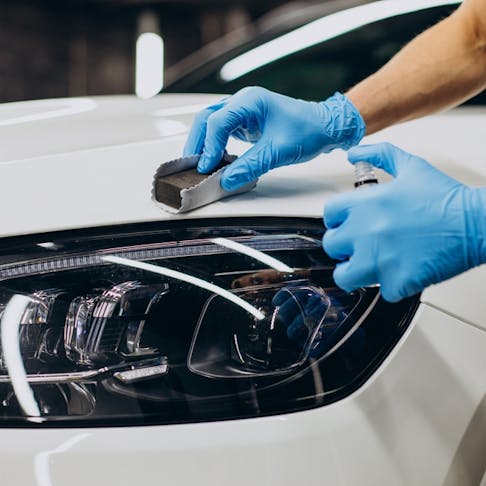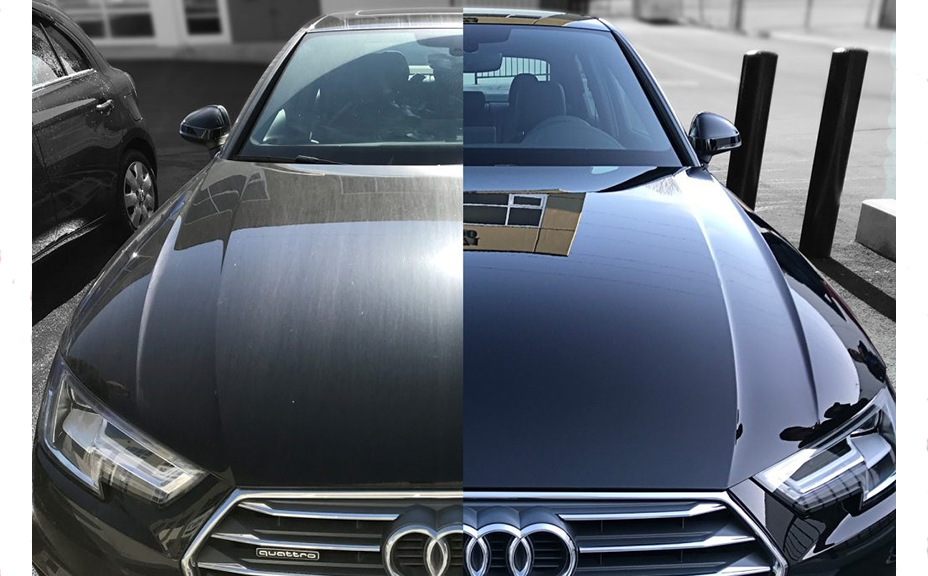Checking out the Science Behind Car Ceramic Coating and Its Protective Properties
The scientific research of car ceramic coating presents a remarkable study in innovative auto protection. Composed largely of silicon dioxide and polymers, these coatings create a robust bond with car paint. This communication improves resilience against environmental hazards while offering hydrophobic benefits. Nevertheless, the intricacies of how these coverings work and their long-term advantages continue to be less recognized. Unloading these details discloses why ceramic layers are coming to be a recommended option for car care
What Is Ceramic Coating?
Ceramic coating is a fluid polymer that chemically bonds to the surface area of a lorry's paint. This sophisticated protective layer improves durability and supplies remarkable resistance to environmental elements. Unlike traditional wax or sealants, which offer temporary protection, ceramic coatings develop a durable guard that can stand up to severe conditions such as UV rays, acidic impurities, and severe weather condition. When applied appropriately, the coating forms a hydrophobic surface area, causing water to grain and slide off, which assists in maintaining the lorry's cleanliness. Additionally, it provides enhanced gloss and depth to the paint, making the automobile appear more refined and vibrant. The application process generally entails complete surface area preparation, consisting of cleaning and polishing, to ensure peak bonding. Because of this, ceramic coverings are coming to be significantly preferred amongst car fanatics and those looking for to shield their financial investments, promising to maintain the car's visual appeal while minimizing the regularity of upkeep.
The Make-up of Ceramic Coatings
The intricate solution of ceramic layers mostly includes silicon dioxide (SiO2), which is stemmed from natural sources like quartz and sand. This vital component provides the structure for the coating's toughness and safety top qualities. Along with SiO2, ceramic layers frequently consist of numerous polymers and ingredients that enhance adhesion, versatility, and resistance to ecological elements. These substances function synergistically to create a robust obstacle versus pollutants such as dust, chemicals, and UV rays.Furthermore, some solutions incorporate titanium dioxide (TiO2) or other nanomaterials, which can increase the coating's hydrophobic homes, leading to better water repellency. The specific make-up can differ significantly among manufacturers, impacting performance and long life. Inevitably, the combination of these aspects culminates in a protective layer that not only enhances the aesthetic appeal of automobiles however additionally offers to lengthen their life-span by securing the surface from potential damage.
How Ceramic Coatings Job
Recognizing just how ceramic finishes work involves discovering their chemical structure, which adds to their protective top qualities. The application process is crucial for accomplishing ideal outcomes, while durability and toughness elements identify the coating's effectiveness with time. With each other, these elements highlight the advantages and efficiency of ceramic coverings for vehicle defense.
Chemical Composition Explained
While numerous car proprietors look for resilient protection for their cars, the chemical composition of ceramic layers plays a critical duty in their effectiveness. These coverings primarily include silicon dioxide (SiO2), which is stemmed from natural minerals. This substance forms a solid bond with the car's paint, creating a long lasting, protective layer. Furthermore, many ceramic finishes include titanium dioxide (TiO2), improving their hydrophobic residential or commercial properties and resistance to UV rays. The presence of polysiloxanes can further improve flexibility and resilience. With each other, these elements add to the coating's capability to push back water, dirt, and pollutants, while additionally offering a high-gloss surface. Understanding this chemical foundation assists car proprietors appreciate the robust security offered by ceramic finishings.
Application Refine Overview
Applying ceramic finishes entails a careful procedure that guarantees optimal bonding and security for the vehicle's surface area. Originally, detailed cleansing and purification of the car's exterior are carried out to eliminate dust, crud, and previous waxes. This action validates that the surface area is without impurities that could impede bond. Following this, the paint is typically polished to boost clearness and remove any kind of flaws. Once prepared, the ceramic coating is used in little areas utilizing an applicator pad, permitting uniform protection. The coating is then left to cure, forming a strong chemical bond with the surface area. Proper useful link curing times and problems are important, as they verify the coating attains its maximum performance and safety high qualities.
Long Life and Toughness Factors
Ceramic coatings are designed to give durable defense with their innovative chemical make-up, which develops a robust obstacle against environmental contaminants. The durability of these coatings is affected by factors such as the density of the application, the high quality of the product, and the problems under which the car is exposed. High-quality ceramic layers can last a number of years, resisting scrapes, UV rays, and chemical spots. Correct upkeep, consisting of routine washing and periodic reapplication, can additionally improve long life. Furthermore, environmental variables like climate and exposure to pollutants can affect the life expectancy of the coating. Overall, when applied and preserved appropriately, ceramic layers provide outstanding toughness, making them a popular option for car fanatics seeking to protect their lorry's appearance.
Hydrophobic Residences and Water Repellency
Hydrophobic residential properties are a characteristic of high quality car more helpful hints ceramic layers, significantly boosting the automobile's surface area performance. These finishes develop a molecular bond with the car's paint, resulting in a surface that pushes back water effectively. When water comes right into contact with a ceramic-coated surface, it beads up and rolls off, minimizing the quantity of fluid that stays on the paint. This behavior not only adds to a visually pleasing look however additionally decreases the buildup of impurities such as dirt, gunk, and road salts.The enhanced water repellency results in easier cleansing and upkeep, as much less effort is called for to get rid of unwanted compounds. On top of that, the hydrophobic nature of ceramic finishings assists in preventing water places, which can mar the surface of uncoated surface areas. In general, the consolidation of hydrophobic homes in ceramic layers plays an important role in maintaining the vehicle's pristine look while simplifying upkeep.
Defense Versus Scratches and UV Damages
Car ceramic finishings provide substantial defense versus scratches and UV damage. The scrape resistance system creates a durable layer that takes in influences, while the UV protecting benefits assist preserve the car's paint honesty with time. Together, these functions contribute to a longer-lasting and aesthetically attractive coating.
Scratch Resistance System
Making use of advanced innovation, ceramic finishings give a robust shield versus scrapes and UV damage, improving the durability and look of vehicle surfaces. The scratch resistance system of these coatings is credited to their one-of-a-kind molecular framework, which develops a resilient bond with the vehicle's paint. This bond produces a hard, safety layer that can take in effects and stand up to abrasions. Additionally, the smooth surface area of the coating lowers rubbing, making it tough for contaminants to adhere and cause scratches. The chemical make-up of ceramic finishings often consists of nanoparticles that strengthen the safety layer, further enhancing its strength. Consequently, lorries treated with ceramic coverings display noticeably improved scratch resistance compared to conventional wax or sealants, making sure an immaculate coating gradually.
UV Protecting Conveniences
The safety qualities of ceramic coverings prolong past scratch resistance to include considerable UV protecting benefits. These coverings create a robust barrier that mirrors unsafe ultraviolet rays, guarding the lorry's paint and underlying products. Prolonged direct exposure to UV radiation can cause fading, oxidation, and deterioration of the paint coating. By incorporating ceramic finishes, vehicle owners can properly mitigate these risks, maintaining the visual allure and stability of their vehicles. In addition, the UV blocking residential or commercial properties add to enhanced durability, lowering the frequency of repainting and upkeep. Ultimately, the combination of ceramic finishings discover this provides a comprehensive remedy for safeguarding cars from the damaging impacts of sunlight exposure, making certain a sustained, vivid appearance over time.
The Longevity and Upkeep of Ceramic Coatings

Regularly Asked Concerns
Can Ceramic Coating Be Applied to Any Sort Of Vehicle?
Ceramic coating can be related to different sorts of vehicles, including autos, trucks, and motorbikes. Nonetheless, surface preparation and compatibility with specific materials are essential for perfect adhesion and efficiency of the coating.
How Much Does Ceramic Coating Usually Cost?
Ceramic coating generally costs in between $500 and $2,000, relying on variables such as car dimension, coating high quality, and specialist application. The financial investment can supply long-lasting security and boost the car's appearance in time.

Is Professional Application Necessary for Best Results?
The requirement of specialist application typically depends upon wanted results. Specialists typically assure appropriate surface area prep work and application strategies, leading to suitable bonding and long life of the coating, which may be challenging for unskilled individuals to achieve.
Can Ceramic Coatings Be Removed or Repaired?
Ceramic coatings can be gotten rid of or fixed, though the procedure may require specific solvents or methods - Ceramic Coating Newark. Proper elimination is important to avoid damage to the underlying surface, highlighting the value of professional assistance for optimal outcomes
Exactly How Does Porcelain Coating Compare to Traditional Wax?
The comparison in between ceramic coating and typical wax discloses that ceramic layers provide remarkable resilience, boosted protection against environmental impurities, and longer-lasting luster, while wax requires extra regular application and gives less overall resistance to damage.